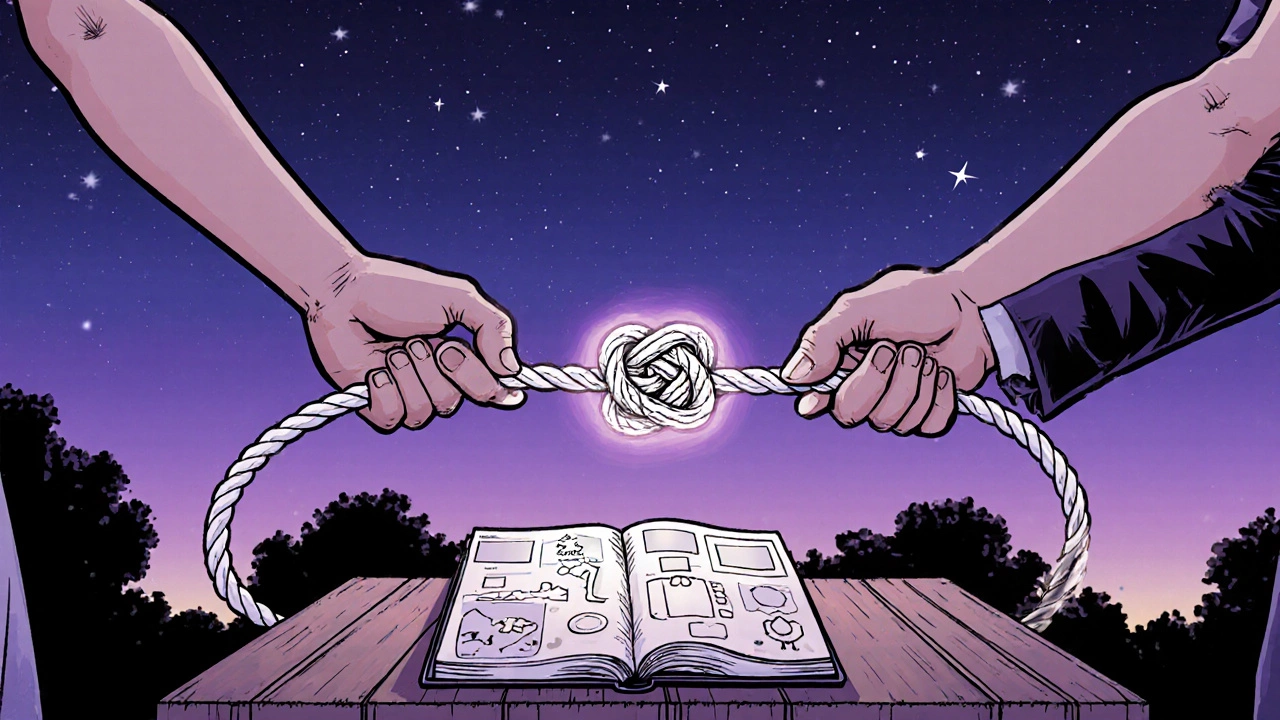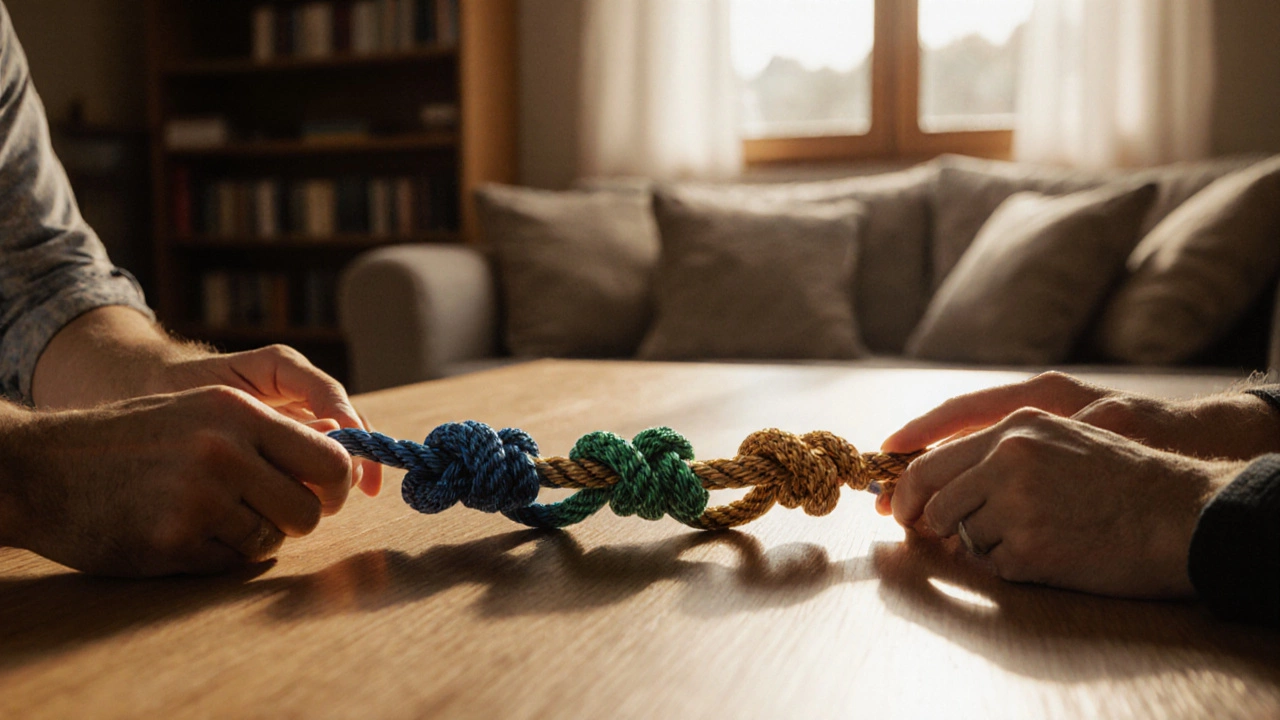Marriage Knots Progress Tracker
Use this tracker to monitor your progress on the three essential marriage knots. Rate your current level of practice for each knot and track improvements over time.
Trust
The foundation of reliable partnerships
Communication
Aligning thoughts and feelings clearly
Shared Vision
Moving together toward common goals
When couples talk about keeping their marriage "tied together," they often use the image of a rope with sturdy knots. marriage knots isn’t just a catchy phrase - it’s a practical roadmap that helps partners secure trust, stay connected, and move forward with shared purpose.
Quick Takeaways
- Three core knots - Trust, Communication, Shared Vision - act as the foundation of any lasting partnership.
- Each knot has concrete actions you can practice daily.
- Use the step‑by‑step guide to turn abstract ideas into habit‑building rituals.
- Avoid common pitfalls like over‑promising, silent resentment, and drifting goals.
- Check the FAQ at the end for quick answers to typical concerns.
What the "Three Knots" Metaphor Means
Think of a marriage as a rope made of many fibers - love, habit, shared memories, and future plans. If the rope is loose in one spot, the whole structure can wobble. The Three marriage knots represent three critical pillars that keep the rope tight and resilient. When each knot is tied correctly, the partnership can weather stress, change, and everyday fatigue.
Knot #1 - Trust
Trust is the first knot because, without it, every conversation feels like a risk. It’s not just about fidelity; it’s about believing the other person will act in the relationship’s best interest, even when you’re not looking.
Trust the confidence that your partner will act reliably and honestly can be built through three simple habits:
- Deliver on small promises. If you say you’ll pick up groceries, do it. Consistency in tiny actions creates a trust bank.
- Share your calendar openly for at least a month. Transparency about where you’ll be reduces assumptions.
- Practice "radical honesty" once a week - share a thought or feeling you’ve been holding back, even if it feels uncomfortable.
When these habits become routine, the trust knot feels solid and unbreakable.
Knot #2 - Communication
Even the strongest rope can fray if the fibers aren’t aligned. Communication is the process that aligns those fibers, ensuring both partners move in the same direction.
Communication the exchange of thoughts, feelings, and needs in a clear and respectful way thrives on three core techniques:
- Active listening. Mirror back what your partner said before responding - "So you’re feeling overwhelmed at work, right?"
- Use the "I" statement format to own your emotions - "I feel anxious when plans change at the last minute."
- Schedule a weekly "check‑in" that lasts 15minutes, free from phones and chores, to discuss what went well and what needs tweaking.
Practicing these methods prevents misunderstandings from turning into stubborn knots.

Knot #3 - Shared Vision
The final knot ties the rope to a common anchor point: a shared vision for the future. Without it, couples drift apart, each pulling in a different direction.
Shared vision a mutually agreed set of long‑term goals and values that guide joint decisions can be clarified through three concrete steps:
- Write down individual life goals (career, family, health) and then merge them into a joint document.
- Identify three "anchor values" - like "financial independence," "continuous learning," or "spiritual growth" - that will steer major choices.
- Revisit the vision board every quarter; adjust as life circumstances evolve, but keep the core anchor values constant.
When both partners see the same destination, the rope stays tight, no matter the terrain.
Step‑by‑Step Guide to Tie All Three Knots
- Set the stage. Choose a relaxed evening, no kids, no screens. This signals that the work is valuable.
- Start with Trust. Each partner lists three recent promises kept and one promise missed. Discuss how the missed promise can be avoided next time.
- Move to Communication. Use a timer: 5minutes each to share a personal concern, while the other practices active listening. Switch roles.
- Lock in Shared Vision. Open the joint goal sheet, read each section aloud, and highlight any mismatches. Agree on a short‑term action (e.g., start a joint savings account).
- Seal the knots. End the session with a symbolic gesture - tying a real rope knot together, or simply placing both hands on a shared journal.
Repeating this ritual every three months reinforces the knots and keeps them from loosening.
Common Pitfalls & How to Avoid Them
- Over‑promising. If you constantly say "I'll change" without follow‑through, the trust knot weakens. Keep promises realistic.
- Silent resentment. Letting grievances sit creates hidden tension. Use the weekly check‑in to surface small issues before they grow.
- Goal drift. When life events (new job, kids) pull partners in different directions, revisit the shared vision regularly.
- One‑sided effort. Both partners must invest in each knot. If one person always initiates, fatigue sets in. Rotate responsibilities.
Quick Reference Checklist
| Knot | Key Action | Frequency |
|---|---|---|
| Trust | Deliver on small promises, share calendar, practice radical honesty | Daily / Weekly |
| Communication | Active listening, "I" statements, weekly 15‑minute check‑in | Weekly |
| Shared Vision | Joint goal sheet, anchor values, quarterly vision review | Quarterly |
Next Steps for Different Couple Types
Newlyweds - Focus on building trust through daily habit tracking. The first 6 months are ideal for establishing communication rhythms.
Couples with kids - Schedule the weekly check‑in during a babysitter hour. Use shared vision sessions to align parenting philosophies.
Long‑distance partners - Leverage technology for calendar sharing and virtual rope‑tying rituals (e.g., video‑call knot demonstration).

Frequently Asked Questions
Can the three knots work for non‑traditional relationships?
Absolutely. Trust, communication, and a shared vision are universal pillars. How you define each pillar may vary, but the underlying actions stay relevant across any committed partnership.
What if one partner resists the weekly check‑in?
Start with a shorter 5‑minute version and frame it as a "quick sync" rather than a formal meeting. Highlight how the habit prevents larger conflicts later, reinforcing its practical value.
How do we keep the shared vision fresh as life changes?
Treat the vision board like a living document - add, remove, or re‑weight goals every quarter. Celebrate milestones to keep motivation high.
Is it necessary to tie all three knots at once?
While you can focus on one at a time, addressing them together creates synergy. For example, improving communication often strengthens trust automatically.
What are signs that a knot is loosening?
Frequent misunderstandings (communication), broken promises (trust), or drifting life goals (shared vision) all signal that a knot needs retightening.



